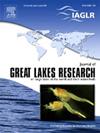Effects of increasing tile drainage and seasonal weather patterns on phosphorus loading from three major Canadian Lake Erie tributaries
IF 2.4
3区 环境科学与生态学
Q3 ENVIRONMENTAL SCIENCES
引用次数: 0
Abstract
Tile-drainage area has expanded across the Canadian Lake Erie watershed in recent decades, and effects on phosphorus (P) loading are unclear. Eleven years (2010 to 2021) of daily P, total suspended solids (TSS), discharge, and climatological data were aggregated from three Canadian tributaries that form a gradient of tiled areas: East Sydenham River (ESR, 60% tile), Thames River (TR, 48% tile), and Grand River (GR, 23% tile). Instead of using traditional seasons (winter, spring, summer, fall), we classified seasons by air temperature to highlight hydrological periods of importance for P loss through tile drains. Seasons included frozen (<−3.2 °C), thawing (−3.2 – 6.7 °C), bare (6.7 – 15.9 °C), and growing (>15.9 °C). Nonparametric comparisons revealed that during every season, the ESR and TR had significantly higher soluble reactive P (SRP) and total P (TP) concentrations than the GR. For %SRP, the ESR was significantly higher than the other rivers during every season, while for TSS, the GR was significantly higher than the other rivers during every season. Only during the thawing season were positive relationships observed in every river between year-over-year tile-drainage proportion and associated P loadings and concentrations. The ESR was the only river to yield significant relationships between tile drainage and P in all seasons except the frozen season. Our findings suggest that increases in tile-drainage area can lead to increases in SRP loading to Lake Erie from Canadian tributaries, especially during the thawing season. However, effects of tile drainage are moderated by differences in soil texture, land-use-land-cover, climate, and point sources.
瓦片排水量增加和季节性天气模式对加拿大伊利湖三大支流磷负荷的影响
近几十年来,加拿大伊利湖流域的瓦片排水面积不断扩大,对磷(P)负荷的影响尚不清楚。我们汇总了加拿大三条支流 11 年(2010 年至 2021 年)的日磷、总悬浮固体 (TSS)、排水量和气候数据,这三条支流形成了一个梯度的瓦片排水区:东西德纳姆河(ESR,60% 的瓦片)、泰晤士河(TR,48% 的瓦片)和大河(GR,23% 的瓦片)。我们没有使用传统的季节(冬、春、夏、秋),而是根据气温对季节进行了分类,以突出通过瓦渠流失磷的重要水文时期。季节包括冰冻期(-3.2 °C)、解冻期(-3.2 - 6.7 °C)、裸露期(6.7 - 15.9 °C)和生长期(15.9 °C)。非参数比较显示,在每个季节,ESR 和 TR 的可溶性活性 P(SRP)和总 P(TP)浓度都明显高于 GR。就可溶性活性磷而言,ESR 在每个季节都明显高于其他河流;就总悬浮固体而言,GR 在每个季节都明显高于其他河流。只有在解冻季节,每条河流的瓦片排水比例与相关的 P 负荷和浓度之间才会出现正相关关系。除冰冻季节外,ESR 是唯一一条在所有季节都能发现瓦片排水与磷之间存在显著关系的河流。我们的研究结果表明,瓦片排水面积的增加会导致加拿大支流对伊利湖的可吸入颗粒物负荷增加,尤其是在解冻季节。然而,土壤质地、土地利用、土地覆盖、气候和点源的不同会缓和瓦片排水的影响。
本文章由计算机程序翻译,如有差异,请以英文原文为准。
求助全文
约1分钟内获得全文
求助全文
来源期刊

Journal of Great Lakes Research
生物-海洋与淡水生物学
CiteScore
5.10
自引率
13.60%
发文量
178
审稿时长
6 months
期刊介绍:
Published six times per year, the Journal of Great Lakes Research is multidisciplinary in its coverage, publishing manuscripts on a wide range of theoretical and applied topics in the natural science fields of biology, chemistry, physics, geology, as well as social sciences of the large lakes of the world and their watersheds. Large lakes generally are considered as those lakes which have a mean surface area of >500 km2 (see Herdendorf, C.E. 1982. Large lakes of the world. J. Great Lakes Res. 8:379-412, for examples), although smaller lakes may be considered, especially if they are very deep. We also welcome contributions on saline lakes and research on estuarine waters where the results have application to large lakes.
 求助内容:
求助内容: 应助结果提醒方式:
应助结果提醒方式:


